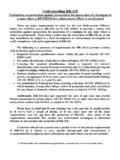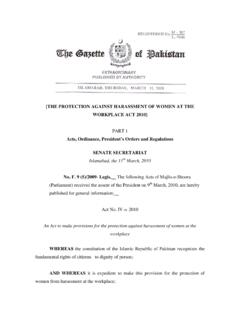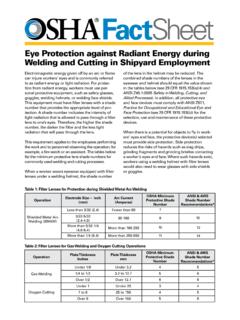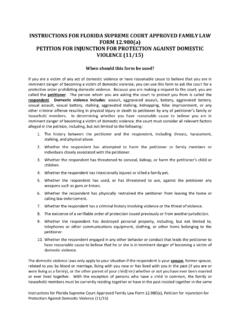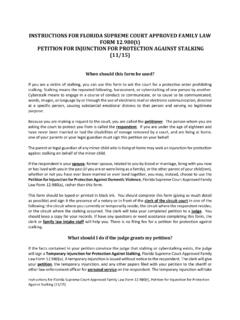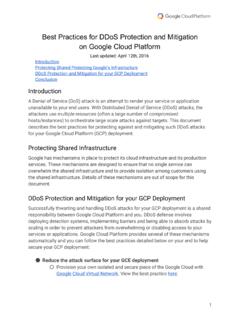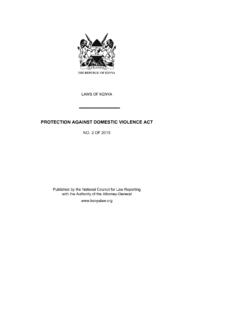Transcription of DURATION OF PROTECTION OF COVID-19 VACCINES …
1 DURATION OF PROTECTION OF COVID-19 VACCINES AGAINST CLINICAL DISEASE. SAGE 9 September 2021 Background Real world effectiveness data has consistently shown high levels of PROTECTION of COVID-19 VACCINES against clinical disease, above all against severe disease outcomes such as hospitalisation and mortality.(1-7) PROTECTION against severe disease appears to be maintained with variants of concern, including the Delta variant currently in circulation in the UK.(8) COVID-19 VACCINES have been in use for approximately 9 months in the UK.
2 Initially a 3-week interval between doses of the Pfizer vaccine was used, however, this was changed to a recommendation for an extended (12 week) interval for all VACCINES early on in the programme. Therefore, some of the earliest vaccinated groups will have now received their full course of vaccination up to 6 months ago. Immunogenicity data suggests that antibody titres wane relatively rapidly following two doses of vaccine.(9) Emerging data also suggests that PROTECTION against infection is beginning to wane, though this may also be related to the emergence of the Delta variant.
3 (7) This has been seen most notably in Israel where a 3 week schedule was used and where the longest follow-up data is available.(10, 11) Here we present the latest PHE data on vaccine effectiveness (VE) against clinical disease by period after a two-dose course of vaccine. Methods A test negative case control design was used to estimate VE against symptomatic disease, hospitalisation and death. In brief, we compared vaccination status in persons with symptomatic COVID-19 with vaccination status in persons who reported symptoms but had a negative test.
4 This approach helps to control for biases related to health-seeking behaviour, access to testing, and case ascertainment.(1, 6) Community testing (Pillar 2) data between 8th December 2020 and 20th August 2021 were included in the analysis. Data were restricted to persons who had reported symptoms, and only persons who had undergone testing within 10 days after symptom onset were included, in order to account for reduced sensitivity of PCR testing beyond this period. Individuals who had previously tested positive (PCR or antibody) prior to vaccination were excluded from the analysis.
5 Prior to May 2021 the main COVID-19 variant in the UK was the Alpha variant, since May the Delta variant has dominated. Cases were assigned to Alpha or Delta variant first on whole genome sequencing, second based on the S-gene target status (negative prior to 28th June 2021 = Alpha, positive from 12th April 2021 = Delta), any cases where sequencing or S-gene testing was not done were considered to be Alpha up to 2nd May 2021 and Delta from 24th May 2021. Analyses were stratified by the following age group, for each age group data were included from the period that general population cohorts in these age groups began receiving vaccine as follows: 80+: first dose from Dec 8th, 2021 (includes those who received doses 3 weeks apart) 65+: First dose and cases from Jan 4th, 2021 40-64: First dose and cases from Feb 1st, 2021 16-39.
6 First dose and cases from May 10th, 2021 (not shown due to limited follow-up) Symptomatic infection was defined as any individual testing positive who reported symptoms consistent with COVID-19 at the point of requesting a test (high temperature, new continuous cough, or loss or change in sense of smell or taste). Hospitalisation data was extracted from the Emergency Care Dataset and included all individuals admitted to hospital via emergency care within 21 days of a positive test, except for those coded as an injury. A sensitivity analysis was also conducted restricted to those with a COVID or respiratory code.
7 To allow for lags in hospitalisation data and the 21 day follow-up, only those tested by 30th July 2021 were included. Deaths data were taken from the patient demographic service. Deaths within 28 days of a positive test were included. To allow for lags in death data and the 28 day follow-up, only those tested by 12th July 2021 were included. For all outcomes the control group were symptomatic individuals who tested negative, irrespective of the outcome in the control. All analyses are undertaken by time of symptom onset in relation to the second dose of vaccine, divided into the following periods: 0-3 days, 4-6 days, 7-13 days, 14-69 days, 70-104 days, 105-139 days and 140+ days.
8 Vaccination status, date and vaccine type is taken from the National Immunisation Management System (NIMS). Adjustments are made for age, sex, index of multiple deprivation, ethnic group, care home residence status (for analyses including adults over age 65), geographic region, period (calendar week), health and social care worker status (for analyses with those aged under 65 years), and status of being in a clinical risk group (only available for age under 65 years) or a clinically extremely vulnerable group (any age).(12, 13) Analyses were also conducted stratified by the clinical risk groups.
9 Here we present an all age analysis against each of the outcomes. For the age stratified analysis, we focus on VE against hospitalisation. Results Figure 1 shows VE against symptomatic disease for all ages. Follow-up data for Alpha is limited as Alpha circulation had stopped by the time the later follow-up periods were reached. VE against Delta is generally lower with the AstraZeneca vaccine than the Pfizer vaccine, but with both VACCINES , waning of VE against symptomatic disease is seen from around 10 weeks, reaching just over 50% with AstraZeneca and just over 70% with Pfizer by 20+ weeks.
10 With the Moderna vaccine, data is not yet available beyond 10 weeks. Figure 1: vaccine effectiveness against symptomatic disease - all ages (a) AstraZeneca Vaxzevria, (b) Pfizer-BioNTech Comirnaty, (c) Moderna Spikevax VE against hospitalisation for the AstraZeneca and Pfizer VACCINES for all ages is shown in Figure 2. Waning against hospitalisation appears to be much more limited, in particular with the Pfizer vaccine where VE of around 95% continues to be seen beyond 20 weeks after vaccination. With the AstraZeneca vaccine, there appears to be some waning to just under 80% VE against hospitalisation from 20+ weeks.










